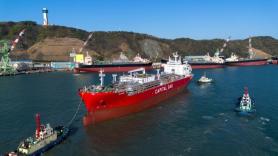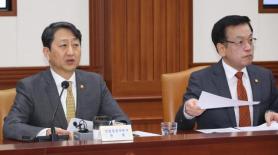
Amid heated competition with China for market dominance in global shipbuilding, South Korea is intensifying concerted efforts to develop liquid hydrogen carriers as the next lucrative frontier for the industry.
The Ministry of Trade, Industry and Energy said on Friday that it has formed a task force for the development of liquid hydrogen carriers.
Liquid hydrogen carriers are seen as next-generation, high-tech vessels that could help South Korean shipbuilders maintain their competitive edge and tap into emerging markets, following their success with liquefied natural gas (LNG) carriers.
These vessels would transport hydrogen in liquid form at temperatures of -253°C, reducing its volume to 1/800th and improving transportation efficiency by more than tenfold, though no commercial large-scale ships of this type currently exist.
In November 2024, the ministry mulled strategies for liquid hydrogen carriers fueled by hydrogen, aiming to use vaporized hydrogen from the cargo or separate non-carbon fuels such as ammonia and hydrogen as the propulsion system for the ships.
Currently, major market player HD Hyundai is pioneering high-pressure direct injection ammonia dual-fuel engines, securing orders for the world's first ammonia-powered vessels in October 2024. In such vessels, hydrogen may also be used as energy sources, as ammonia breaks down into hydrogen and nitrogen.
The push for liquid hydrogen carriers comes in line with the United Nations' campaigns for net-zero coalitions, which aim to cut emissions as much as possible to achieve a balance where greenhouse gas emissions are offset by removals from the atmosphere.
While LNG remains the most readily available option currently, hydrogen is emerging as a prominent alternative to meet global carbon neutrality requirements in the near future.
The ministry pledged to pour approximately 55.5 billion won ($39 million) in liquid hydrogen carriers this year and plans to construct the world's largest demonstration vessel by 2027.
With over 100 organizations participating in around 43 projects simultaneously, the task force will collaborate with shipbuilding companies, universities, and research institutes to accelerate commercialization.
"We will actively support these projects and relevant technologies to develop large-scale liquid hydrogen carriers and facilitate construction processes by streamlining legislation and other measures, while establishing a supply chain for them, with the goal of having them recognized as global standards," said a ministry official.
Copyright ⓒ Aju Press All rights reserved.




